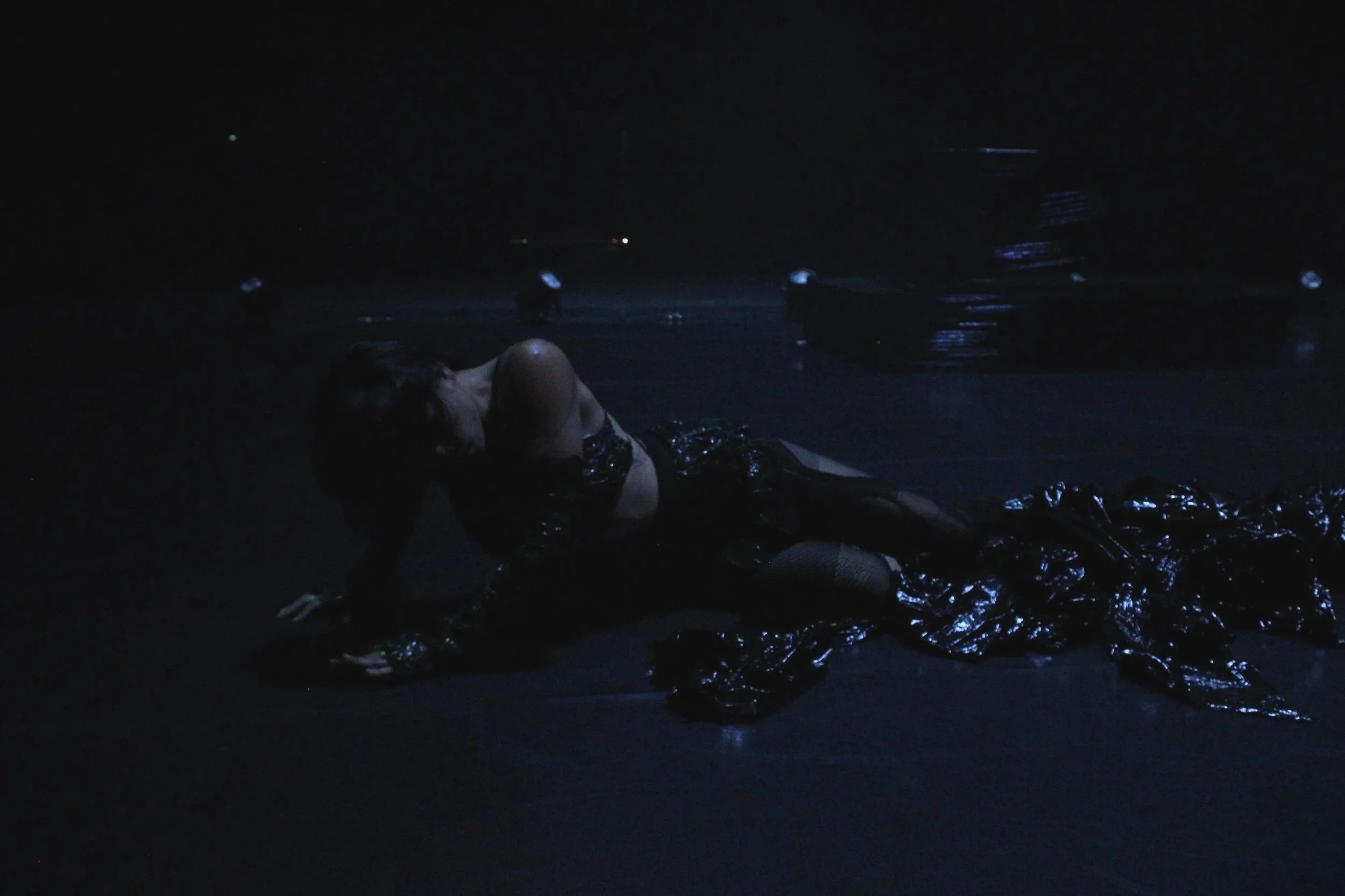SCENOGRAPHY OF ABYSS
“It was already 11:05 and the audience seemed tired, their attention slipping. The side door opened, an aquarium and a cocoon wrapped in black glistening foil were brought in, the atmosphere changed. Phones were put away, eyes fixed and short murmurs exchanged. Suddenly the plastic began to tear and the performer emerged, there was an audible gasp, the audience was magnetized. From above, overseeing lights and stage, I felt the space electrify. In the final red-lit moments, her gaze cut through the audience—and through me—as if the abyss we had created was staring back.”
Documentation of the performance
Scenography of ABYSS
ABYSS is a 15-minute solo dance performance exploring how fear is experienced through the feminine body. Directed and choreographed by Sabina Andrea Allen and performed by Xenia Argyri, it weaves together the myth of Medusa, contemporary movement, and experimental sound. With stage and light design by Valia Lolidou, the performance is structured around a large aquarium that functions as the central scenic element. The scenography of ABYSS is based on the states of concealment and revelation, leading the audience along a path of successive transformations.
The visual sequence begins long before the performer even appears. The silence of the empty stage is interrupted as the side door opens. Two members of the technical staff wheel in a rectangular box wrapped in black plastic, positioning it at the center of the stage. A third follows, placing a large black-covered object at the front left. The setup itself becomes the first act of the performance, incorporating the technical staff as performers. Once they leave the stage, the mute, opaque objects left behind sink back into silence, their black surfaces glistening in the hazy, cold atmosphere.
Concept drawing
The soundscape begins.
Composed by ATNAI (Dimitris Kounatiadis, Pyrros Marmatakis), soft ambient sounds are accompanied by a steady, almost primitive beat, and the black form at the front of the stage starts to stir. Its plastic surface trembles and crackles until it rips open from within. Slowly, the performer emerges, clothed in Helena Stölting’s costume. As soon as the figure steps out of the now-torn black cocoon, she begins moving through the space, dragging the material behind her like the flailing limbs of a jellyfish. The plastic foil shifts seamlessly from stage element to prop to costume, at first bringing to mind the image of a womb and later resembling discarded skin, while retaining its sculptural presence throughout.
Midway through the performance, another major revelation occurs. As the performer’s movements increase in intensity and frequency, the music assumes a ritualistic character, sounding almost like a mystical hymn. The black box in the middle of the stage, backlit in warm light, has one edge exposed, which is struck by a narrow beam of cold light. As the light hits its surface, the water within glows with a pale, ciel hue, revealing what had initially appeared as a sealed black box to be in fact a human-sized aquarium filled with water.
With only few minutes remaining, the performer tears the plastic from the aquarium and slips inside, her movements slow, fragile, and gasping. She transforms into a trapped animal, suspended between survival and suffocation. In the final moments, the lights turn red, and the atmosphere grows ominous. Rising, she repeats a compulsive movement of bowing and straightening her body, dipping her hair into the water and flinging it outward. Suddenly, she stops, faces the audience, her gaze both questioning and threatening, before the stage cuts to black.
The scenography of ABYSS, in its sequence, enacts its own metamorphosis, mirroring the transformation of the performer: the black foil shifts from concealment to tentacle to relic, the aquarium from sealed object to luminous body, and the lights from exposure to revelation to menace. Nothing remains static. Material, light, and water carry the performance as much as the body, conveying the visual poetics of the abyss.
Concept drawing
CREATIVE TEAM
Concept/ Idea/ Co-production: Sabina Andrea Allen/ Xenia Argyri
Direction/ Choreography/ Dramaturgy: Sabina Andrea Allen
Dancer/ Performer: Xenia Argyri
Light/ Set Design: Valia Lolidou
Music Composition: ATNAI (Dimitris Kounatiadis, Pyrros Marmatakis)
Opera Vocals: Iony Moschovakou
Fashion Design: Helena Stolting
Video/Edit: Vicky Sagri
Color: Spiros Hrisomallidis
Photography: Marianna Sagri


